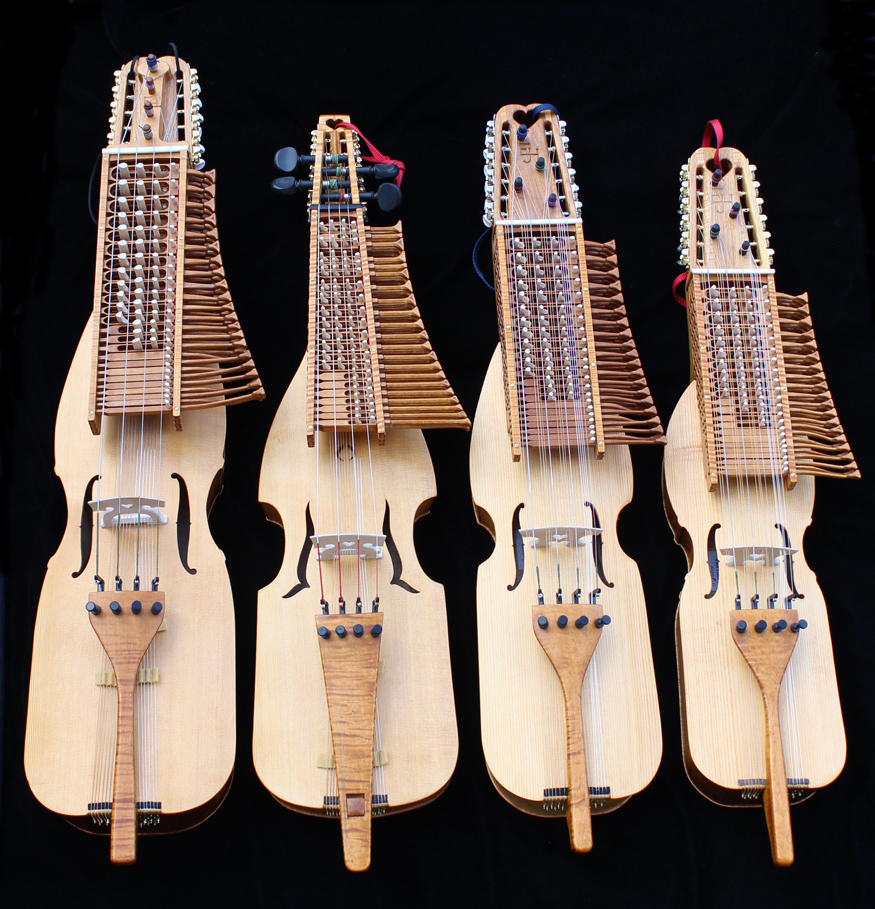Building Nyckelharpas
Earl started building nyckelharpas with a kit from Sören Åhker. Sören had an instruction book in Swedish or English that included full-size plan sheets for a standard full-size and a child- (or small adult) sized nyckelharpa. The full size has a mensur length (nut to bridge) of 400 mm while the smaller plan has a 340 mm mensur length. The plans are metric (in millimeters). These were last printed in 2002, and the supply has run out. We NO LONGER have copies available. Earl has been in contact with Sören and several other builders about potential availability of a new instruction book. When something becomes available, we will update this web site to reflect the changes.
Sören used to sells “kits”. Please be aware that Swedish nyckelharpa kits consist of rectangular wooden blocks of appropriate sizes that make the various parts of the instrument. These kits are very rough by American musical instrument kit standards.
There used to be a DVD available that follows Sören as he builds an instrument. The DVD was made by Rita Leydon and used to be available through her web site. I understand that Reta has run out of copies of this DVD.
Bjorn Bjorn used to have an extensive array of plans for various Swedish nyckelharpa models. He is now fully retired and no longer has any of his plans.
If you think you are interested in building a Nyckelharpa, we are not currently aware of any available plans/instructions. If you do happen to find a set of plans, it please feel free to contact Earl about any questions or parts you might need. He can put together as much of a kit as you need. You can probably get some of the wood you need for an initial instrument locally.
If you are building a nyckelharpa and have questions, please feel free to contact Earl. He is willing to provide distance assistance to help you get your nyckelharpa done. It doesn't matter if your instrument materials came from us or not.
We have the following supplies in stock:
•tops
•backs
•strings
•6 in-line guitar tuners
•bridge blanks
•cello fine tuners, both full- and 3/4-size
•thick stock butternut for sides and necks
•thick stock figured maple for the tail piece
•yellow birch and figured maple for the key box
Most of the rest of the materials should be easily obtainable in the U.S. Contact Earl for more information and prices.
For shaping the top of the body, Sören recommends a piece of bent 1/8-inch thick aluminum plate. Call around to sheet metal shops to find one that has this type of metal and a bending roller to get the correct bend in it.
You will also need a sheet metal tray to boil the top for bending. Any sheet metal shop should be able to make this for you.
A note on tuning: In Sören's book, he recommends tuning the sympathetic strings for an advanced player. We recommend that you tune them chromatically, starting on G for the lowest sympathetic string and going up by 1/2-steps to the F sharp on the highest string.
Our son Ian had been making key box kits. Due to some life path issues, he has discontinued this venture for the foreseeable future. Due to Earl's focus on new instruments, he does not have the time for the key box kits.
About the wood used to build Nyckelharpas: In Sweden, the body (neck, sides & tail block) are typically made from “Gran”. If you check the Latin genus/species name you will find that in the USA we refer to this as Norwegian spruce. Birch is also sometimes used for the body. The Swedes use alpine spruce for the top of the body (imported from Germany). Backs are typically either spruce or maple. A spruce back will give a somewhat “brighter” sound while a maple back usually gives a “warmer” sound. Many players with a violin background prefer maple backs. The key box is usually birch, but can be maple or beech. The keys are made mostly of birch, but sometimes maple or beech. The tail piece is usually maple.
What types of woods can be used for building a Nyckelharpa: The top should be quarter-sawn spruce. You want a good tone wood for the top. The back is typically either spruce or maple. Again, usually quarter-sawn. Other woods are sometimes used.
You can use almost any wood for the rest of the instrument, but you do not want to make it too heavy. For information on wood properties, I recommend the USFS Wood Handbook.
Earl uses butternut for the body, originally because he had some on hand when he started building. It is lightweight and has good working properties. Many builders use pine, spruce, or poplar for the body. Poplar is often used for bodies in Europe, outside of Sweden. Earl uses birch for keys. Maple also works well. Leif Alpsjö recommends not using black walnut for the keys or key guides due to sticky key issues.
(Note: any text that is a different color and underlined is a link to another web page. Clicking on it will take you there.)
(This page last updated 08/20/2025)
